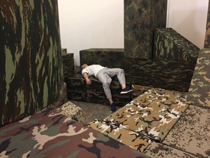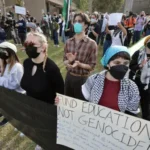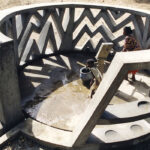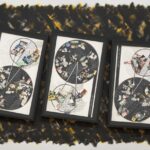d is for…?
documenta and the politics of (re)presentation
Nanne Buurman
* Based on a lecture at the conference Exhibiting Postcolonialism. Museum Culture in Contemporary Germany and Europe, University of Illinois, Chicago 26-27th April 2018.
Inspired by documenta 14’s attempt to re-think and transform public spheres in face of the current crisis (or crises) of democracy, my contribution will consider how documenta, from its inception in 1955, projected particular notions of democracy. More specifically, I will take the exhibition series as a case study to argue that broader shifts in the curatorial field from regimes of historicity to regimes of inclusivity cannot simply be understood as emancipatory diversifications but also sometimes entail the risk of Undoing the Demos, as Wendy Brown calls it in her problematization of the repressive tolerance of neoliberalism. Attempts to democratize exhibitions in terms of identity politics and representation sometimes seem to reduce democracy to questions of quotas, proportion and access, rather than agency, power and participation, thus risking to incorporate, neutralize and depoliticize difference while leaving national/ist, Eurocentric, patriarchal, racist or capitalist frameworks unchallenged, not least due to the fact that inclusion always also entails other exclusions. The aim of my contribution therefore is to complicate the all too easy associations of large-scale exhibitions, like documenta, with democracy that disregard the various regimes of governmentality at work in curatorial constellations and beyond.
Curators are not democratically elected and their selections of art works as well as the crowd management in institutions always entail governmental choices, so – despite best intentions – power is still centralized to a certain extent, which is why curators are time and again framed in monarchic terms as rulers, kings, gods or even dictators, even if they do their best to demonstrate the collective character of their work or to soften hierarchies. On the other hand, curatorial powers are limited by institutional structures, socio-economic conditions and political contexts that so often remain a blind spot in the analyses of exhibitions and their curators’ auctorial intentions. With this in mind, the following essay will first provide some very brief historical spotlights on the weaponizing of documenta as an instrument of more or less democratic re-education of German post-Fascist publics in the context of the so-called Cold War before I secondly discuss how after the fall of the Berlin Wall in 1989 different documenta exhibitions reacted differently to the democratic challenges of increasingly globalized capitalism. The aim is not to do justice to each individual edition or the institution of documenta at large. Instead, I will use the exhibition series as just one example amongst many biennials to call attention to the complicated politics of re/presentation in the field of curation, where claims of diversity and democracy all too often go hand in hand with a domestication, neutralization or commoditization of difference that represses the “impossibility of representation” (Donald Preziosi) as a constitutive condition of democracy, within exhibitions and beyond.
Looking at the prehistory of contemporary exhibition culture, Preziosi stresses the important role museums and exhibitions played in the consolidation of the modern nation states and the ways in which their entanglements with colonialism and capitalism contributed to shaping at once universalist and racist modern epistemologies. With regard to 19th century world fairs, he notes that “All specimens in this vast archive sit as delegates or representatives – that is, as representations – in a congress of imaginary equals, as the myriad of manifestations making up a universal world history of art. To each is allotted a plot and display space, a platform or a vitrine.”[1] During this expository “de-othering of others [that] domesticates all difference”[2] and fetishizes it as “but stylistic variations of the same,” [3] according to Preziosi, “Even the most radically disjunctive difference could be reduced to […] different (but ultimately commensurate) approaches to artistic form (the Inuit, the Greek, the Welsh, etc.).”[4] It is against this backdrop that he called attention to the fact that “Art History had been grounded in the repression of the impossibility of representation.”[5]
In his contribution to the catalogue of documenta 14, Tony Bennett develops a similar argument observing a replacement within the “exhibitionary complex” of an “evolutionary ordering of the relations between peoples and cultures by nonhierarchical conceptions of cultural difference.”[6] Remarkably, he links this phenomenon, which he sees being driven by the discipline of anthropology, influenced by “late-nineteenth-century German humanistic conceptions of cultural difference,”[7] to Wendy Brown’s analysis of liberal tolerance that “manages the demands of marginal groups in ways that incorporate them without disturbing the hegemony of the norms that marginalize them.”[8] Both Preziosi and Bennett thus call attention to certain problems that the entanglement of politics and aesthetics entailed historically in art’s historiography and exhibition making. They thereby extend on the Benjaminian insight that “visibility does not equal power,” as Peggy Phelan phrased it to warn against confusing aesthetic and political representation.[9] Against this backdrop, another aim of the following essay is to caution attempts to politicize exhibitions in the name of an ethics of representation that sometimes tend to conflate diversity with democracy and thus risk domesticating difference in the name of an identity politics that reinforces essentializing notions of cultural identity rather than un-doing the economic, epistemological and expository structures and practices that continue to re/produce these very identities in hierarchical terms.
Representations of Nationality, or: documenta as an (Inter)National Exhibition
documenta was founded in 1955 in Kassel as a private initiative of some local artists and art lovers. The first edition of the exhibition series thus not only happened to take place in the very year of the Federal Republic of Germany’s (FRG) formal political independence from the Allied Forces and the FRG’s joining of NATO but also coincided with the Bandung Conference, one of the first assemblies of the Non-Aligned movements of ‘Third World’ bloc free states. Despite the exhibition’s role in the re-construction of West Germany’s cultural identity after the atrocities of the ‘Third Reich’ and its first editions’ coincidence with decolonial liberation movements, the specific geo-political relations between German colonialism, nationalism and post-war nation building were not explicitly addressed in the history of documenta until its fourteenth edition in 2017. In the Neue Galerie, for instance, a portrait of one of documenta’s founding fathers, Arnold Bode, was juxtaposed with posters promoting the Marshall Plan and a copy of Richard Wright’s book The Color Curtain. Report from the Bandung Conference (1956). Moreover, the so-called Benin Bronzes (18th/19th century), looted by British colonizers and sold to museums across Europe, were juxtaposed in one of the gallery’s hallways with eight white marble figures by Carl Friedrich Echtermeier (1876-82) “representing the eight traditional ‘nations of art’: ancient Greece, ancient Rome, Italy, France, Germany, Spain, the Netherlands, and England.”
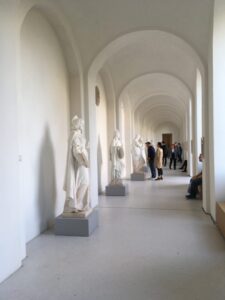
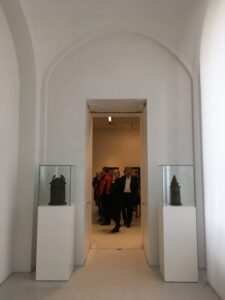
According to documenta 14’s website, this display was intended speak to “the entanglement of nationhood, institution building, and cultural politics,” into which the Neue Gallerie was involved since it was built in 1877 “after modern Germany’s emergence from the Franco-Prussian War.”[10]
Despite (or because) its very specific national history, where the Nazi crimes and the industrialized mass murders of Jews overwrote memories of earlier genocides, not just German colonialism but colonialism in general remained a blind spot of documenta until the curator of the tenth edition, Catherine David, invited celebrities of post-colonial theory to the “100 Days/100 Guests” Series in 1997. German colonial history was first addressed by the artist Dierk Schmidt’s conceptual painting “The division of the world – Tableaux on the legal synopses of the Berlin Africa conference” during documenta 12 (2007) and taken to the curatorial level during documenta 14, where it provided a historical backdrop against which contemporary Germany’s role in the European debt crisis since 2009 could be read as a neo-colonial endeavor. By consciously displacing the curatorial standpoint from Germany to Greece and from Kassel to Athens, documenta 14 also addressed what Viktoria Schmidt-Linsenhoff has called “the colonial unconscious of German art history.”[11] Calling attention to art history’s indebtedness to (ancient) Greece and colonial ethnographic categorization as well as the co-incidence of West-Germany’s post-War independence with the anti-colonial struggles of former German colonies, such as Cameroon and Togo (which gained independence only five years after the FRG in 1960), at least in its Kassel iteration d14 opened up a new perspective for documenta studies. d14 aimed at de/provincializing the art world’s gaze that usually takes lodging in Kassel’s documenta as one of the central apparatuses from where to look at the world, by inviting visitors to change the point of view to look at documenta’s blind spots as one of the art world’s major spectacle lenses. With this change of perspective, d14 especially also challenged the local population to de-familiarize their vision by taking a dis-identifying look from elsewhere at the compromised heritage of German art and exhibition histories and their distorted visions of modernity, haunted by the heritage of colonialism and nationalism.
documenta was founded as a response to the Nazi exhibitions of so-called degenerate art, the first of which was staged in 1937 in the Haus der Kunst in Munich. Nazi cultural politics ostracized primarily modern art’s abstract tendencies and art by leftist or Jewish artists. One of the official goals of the first documenta therefore was reconnecting with the development of modern art before the ‘Third Reich’ and restoring Germany’s image as a ‘cultured’ and ‘modern’ nation after the atrocities of the holocaust and the Second World War by providing a retrospective of modern art since the turn of the century and incorporating especially German expressionism into its teleological genealogy of contemporary abstraction. In the context of post-War re-education and the newly established FRG’s integration into the transatlantic West, tolerance towards and appreciation of modern abstract art were taken as signs of democratic virtue.[12] This resulted in a marginalization of realist tendencies that were increasingly considered as undemocratic in the context of the so-called Cold War and associated with both, former Nazi Realism and Socialist Realism. When the denazification of the FRG was dropped by the Western powers in favor of the containment of Eastern communism, the anti-communism of figures like documenta co-founder Werner Haftmann – who had defended abstraction as inherently Germanic in a Nazi journal – could be easily reconciled with American policies of ‘anti-totalitarian democratization,’ where abstraction was now rebranded as an expression of (capitalist) democracy and freedom.[13]
Besides the recently revealed memberships of Haftmann and several other documenta founders in Nazi organizations such as the NSDAP and/or SA, the early documentas’ ostentatious internationalism and dedication to modern abstraction had many blind spots. It not only downplayed art from the East and political traditions of modernity but also work by Jewish artists persecuted and murdered by the Nazis while showing German artists whose work had been declared degenerate on stylistic grounds despite their sometimes national-socialist leanings, thus contributing to whitewashing Germany’s recent (art) history.[14] Moreover, the declared internationalism of documenta may be better described as a still very limited ‘occidentalism’ with the majority of artists coming from Germany, Italy, France, the Netherlands, Switzerland, England and only three from the USA, as the list of participating countries in the catalogue reveals. [15] In Globalizing Contemporary Art (2010), Lotte Philipsen speculates that the list’s presence “was probably inspired by the organization and catalogues of biennials in Venice and Sao Paulo (est. 1895 and 1951) respectively […]” and that it shows that “the national background of artists and works was deeply naturalized as a significant aspect of the art.”[16] In documenta’s subsequent editions, the artist’s nationality was no longer officially an ordering criterion in the display of the exhibition, although national and ethnic categorization, inherited from the 19th and early 20th century, stayed an issue in the accompanying discourses, with ratios, proportions and counts of national affiliation remaining a very popular sport not just in documenta’s early history but also in contemporary biennial culture at large.[17]
Democracy on Display, or: documenta as a Weapon of the Cold War?
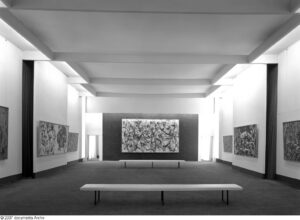
When I just wrote that national representation was no longer explicitly an ordering criterion after the first documenta, this is not entirely true, because there was a significant exception: the selection of the North American contribution to documenta II in 1959 was carried out by Porter McCray from MoMA and the artists from the U.S. were presented in a separate section. Among them was Jackson Pollock (Fig. 2a), whose abstract expressionist paintings were promoted by U.S. art historians like Clement Greenberg as signifiers of artistic autonomy, individualism and freedom. So much so, in fact, that Eva Cockcroft came to the conclusion that abstract expressionism was a “Weapon of the Cold War.”[18] In this light, documenta initiator Arnold Bode’s dedication to primarily expressive modern art and co-curator art historian Werner Haftmann’s promotion of “abstraction as a world language,” a slogan devised in the opening speech, may be read as an ideological affiliation of documenta with the “free West.” Artistic liberation from naturalist representation was considered as an expression of individualism, whereas (socialist) realist art was regarded as “unfree” because it did not cut its ties to extra-artistic reality. The marginalization of political realism in the early history of documenta may thus also be read as a depoliticization of art, with documenta nevertheless serving political functions despite, or rather because of, this denial of politics.[19]
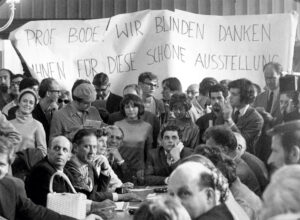
After some disputes over the autocratic leadership or ‘dictatorship of abstraction’ during documenta III (1963), there were attempts to democratize the exhibition’s organization by founding a selection committee to determine which art should be shown. Harald Kimpel called this ostentatious transparency of the quasi parliamentary selection processes during documenta 4 (1968) “democracy as an exhibit.”[20] (Fig. 2b) According to him, these democratizing measures were dysfunctional because they no longer allowed for utopian visions of individual figures like Bode and Haftmann but bureaucratized exhibition making.[21] Because the presence of North American artists increased heavily to make up one third of all invited artists, this edition was dubbed ‘documenta americana.’ Since the “Räte” model was not considered successful, it consequently led to a reorganization of documenta’s constitution that foresees only one person on the helm. For documenta 5 (1972), Harald Szeemann was selected as documenta’s general secretary (what we today call artistic director). His nomination is considered a landmark in the history of curation, among other things, because he introduced the idea of the thematic exhibition as a sort of curator’s work of art – a stance that was heavily criticized by artists who felt that their freedom was infringed, if their works became mere “dots of color” in a curatorial Gesamtkunstwerk.[22] From the total number of artists he chose, more than one third were from the US, so North American art now was defining the canon of contemporary art even more than before. In terms of statistics, a record of 96% of the artists who exhibited at documenta 5 were born in the US and Europe.[23]
These statistics reflect the geopolitical implication of documenta in the ‘Cold War’ re-education of Western German publics often also referred to as ‘Americanization.’ The complex oscillation between continuing patriotic/nationalist mindsets and a willingness to embrace American brand capitalist democracy to forget the involvement of most Germans in the dictatorial Nazi past perhaps explains best why documenta remained an essentially North-Atlantic endeavor until the wall came down in 1989. Remember, Kassel was only 30 km away from the inner-German border to the eastern German Democratic Republic (GDR) and played such an important role in showcasing the Western way of life that it received Zonenrandgebietsförderung (a special financial support for areas close to the border). The exhibition’s role as a bulwark against Eastern communism, which also helped to turn a blind eye to the personal and ideological continuities with Nazism, contributed to constructing a Euro-American (hi)story of modern and contemporary art, whose hegemony was not really challenged until the collapse of the bipolar world order and the ‘victory of capitalism’ in 1989. As Chin-Tao Wu notes, “Before 1992, nearly all the artists originally from Latin America, Asia or Africa had already moved to either North America or Europe before they exhibited in Documenta.”[24]
Capitalizing on Contemporaneity: From Cannibalistic Curation to Post-Colonialism
Remarkably, in his introductory catalogue essay to documenta 9 (1992), curator Jan Hoet neither mentioned the significant historical turning point of 1989 nor the mega-trend that is today called ‘globalization.’ His implicit understanding of globality was still a very optimistic one, in which the ‘victory of capitalism’ is seen as the ‘end of history’ in Fukuyama’s sense as the end of a trajectory towards a state of perfection, where democracy was inextricably linked to capitalism. As Irene Below and Beatrice von Bismarck note, Hoet’s presentation of African and Asian art was still “exoticizing.”[25] The Belgian curator, who was stunned by the fact that “everything was available,” seems to have curated in line with capitalism’s cannibalistic appetite to include the Other.[26] Perhaps his approach to ‘non-Western’ art was inspired by the highly disputed 1989 exhibition Magiciens de la terre in Paris, which has meanwhile become an (in)famous milestone both in exhibition history and in global art studies. Its curator Jean Hubert Martin and his co-curators tried to discover yet unknown artists from around the world in what is often criticized as a quasi-colonial fashion of showcasing their art as a collection of ‘folk,’ ‘naïve’ and ‘primitive’ art untouched by modernism in contrast to canonized Euro-American art works.[27] Thus, non-Euro-American artists came to bear what Kobena Mercer had referred to in 1990 as the “burden of representation,” a logic by which “artists were forced to carry an expectation that cast them as spokespersons for a culture in its entirety.”[28]
This theoretically little-reflected appropriation of ‘world art’ changed with documenta X, curated by Catherine David in 1997. As the first edition informed by postcolonial theory, it problematized the universalist expansion of Western notions of art and its orientalizing Othering of marginalized positions. Nevertheless, still about 90% of the exhibiting artists were natives of Europe and the US. Therefore, Rasheed Araeean criticized that “despite its rhetoric about the issue of globalism, the documenta was meant to privilege and maintain the white exclusivity of the avant-garde.”[29] He took issue with David’s refusal of universalism and her explanation that in many “non-Western cultural zones” “the object of ‘contemporary art’ is often a very recent phenomenon […] linked […] to an acceleration of the processes of acculturation and cultural syncretism […], and in the worst cases, to the demand for rapid renewal of market products in the West.” [30] While the artist maintains that “non-white artists were on the forefront of the postwar avant-garde,” the curator explains that due to “destroyed traditions,” “colonization and decolonization” and “unequal access” “the radicality of contemporary non-Western expressions often finds its privileged avenues in music, oral and written language (literature, theater), and cinema – forms which have traditionally contributed to strategies of emancipation.”
Where d9 – in line with the ongoing logic of counting the nationalities of participants – adhered to an additive historiography, in which an expansion of the canon often leaves the epistemological foundations of art and its historiography intact, documenta X obviously took a different path. Skipping through the catalogue one may notice that indeed only few artists with ‘non-western’ backgrounds participated. According to Araeen, David once said that “Documenta was not the United Nations.”[31] And, indeed, securing proportional representation of cultural backgrounds was not dX’s main issue. But by inviting representatives of post-colonial theory such as Edouard Glissant, Edward Said, Gayatri Chakravorty Spivak and Vandana Shiva as well as theorists of globalization such as Ulrich Beck and Saskia Sassen for the public “100 days – 100 Guests” program, dX was not only an early example of the ‘discursive turn’ in curating but should also be recognized as a first attempt to acknowledge the legacy of European colonialism and to challenge the Eurocentric assumptions of documenta – albeit primarily on a discursive/verbal level (Figs. 3a+b.).
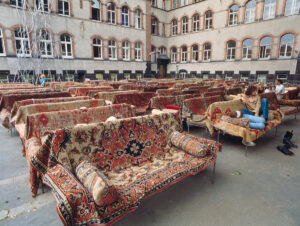

Spatial design by Heimo Zobernig, Chair design by Franz West
Photo Courtesy of Richard Kasiewitz
Source: Harald Kimpel: documenta. Die Überschau (2002), p. 136.
Curatorial Passing: Decentering documenta and Normalizing Difference
Even though David introduced postcolonial theory to documenta, it was Documenta11 (2002), five years later, that has been canonized as the postcolonial documenta. One of the reasons may be that, while dX was the first documenta curated by a woman, D11 was not only the first edition in the new millennium (shortly after 9/11) but also the first edition curated by a ‘non-European’ artistic director, the Nigerian born Okwui Enwezor, who had been living in New York since he was 18 years old. Even though “the proportion of Western artists fell to […] 60 per cent,”[32] still “nearly 78 per cent of the artists featured were living in North America or Europe.[33] So, the reputation of Documenta11 as the postcolonial documenta was facilitated by the fact that it was curated by a non-European man of African descent, who moreover, nominated a diversified team of curators (Carlos Basualdo, Ute Meta Baur, Susanne Ghez, Sarat Mahari and Octavio Zaya). But despite an aesthetics of diversity on all levels of the show’s corporate identity (Fig. 4a), with rainbow colors as one defining feature, Enwezor, according to Oliver Marchart, was not interested in identity politics but rather wanted to document the global social and political conditions of late capitalist modernity, “shedding light on European art’s involvement in colonial history” and “displacing the West from the center.”[34]

At the core of D11’s curatorial concept was a decentering of the exhibition by organizing four discursive platforms in diverse places like Berlin/Vienna, New Delhi, St Lucia and Lagos before the exhibition in Kassel opened (and the five colors of the poster stand for the five platforms). The aim was to investigate the postcolonial condition of globalized capitalism in times of Empire (heavily drawing on Michael Hardt and Antonio Negri’s book by the name) and to constitute a global public sphere (not unlike Hardt and Negri’s “multitude”) by deterritorializing the exhibition. The platform “Democracy Unrealized,” for instance, took place in March and October 2001 in Vienna and Berlin (at the House of World Cultures) to discuss the future of democracy in a postcolonial world characterized by migration and a totalizing domination of the social relations by capitalism.[35] Among the discussants were cultural theorists like Homi Bhabha and Stuart Hall. The latter argued that with the linking of liberal democracy and capitalism, democracy has become an empty signifier.[36] Among other things, he also reminded his listeners that democracy was always constituted by its exclusions of the Other (for instance of women or slaves). This resonates with the theory of Ernesto Laclau and Chantal Mouffe, whose agonistic and counterhegemonic concept of democracy as a never ending struggle calls into question the idea of consensus or finality of democracy, also played a central role in the D11’s discourse.
In the exhibition itself, a lot of the art on display was conceptualism from Europe and South America as well as photo and film documentary, in which artists documented a broad spectrum of local conditions, ethnic conflicts, violent displacements, wars, and migration providing a sort of kaleidoscopic vision of global struggles and hardships, neocolonial exploitation and violence. Relativizing the European central perspective by offering a multiplicity of perspectives from around the world, D11 thus called attention to the global implications of coloniality in the present. In the introductory essay to the show, Okwui Enwezor writes about “postcoloniality” as something that reconfigures “representation of nearness” and demands “for full inclusion within the global system and by contesting existing epistemological logical structures, shatters the narrow focus of Western global optics.”[37] Despite the theoretical concern with postcoloniality, however, Enwezor did not seriously problematize the role of biennials and large scale exhibitions within the (neo)colonial conditions of globalized capitalism.[38] It is striking therefore that despite Enwezor’s explicit intention to call into question the “epistemological structures” and the “narrow focus of Western global optics,” when it comes to display, his curatorial approach reaffirmed the exhibitionary conventions of European modernism, or what Elena Filipovic has called the “Global White Cube.”[39] (Fig. 4b)
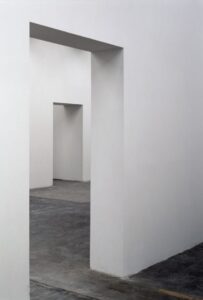
As Peter Weibel wrote in the introduction to his 1996 exhibition Inclusion/Exclusion. Art in the Age of Postcolonialism and global Migration, “The White Cube stands as a synonym for a North-American-European Art, which brackets out all the social, sexual, religious, ethnic differences in the name of aesthetic autonomy and universal language of form, thereby ignoring the social, national, ethnic, religious, gendered conditions for the making of art.”[40] In other words one could say that the White Cube purifies the social space and covers over the fact that it is a racialized and gendered infrastructure. By thus suggesting neutrality, the White Cube reinforces a Western epistemological system that naturalizes an entire nexus of binary concepts by claiming universality. Why, then, did Enwezor choose this highly formalist, clean display? Is it possible that an exhibition for contemporary art can denounce Eurocentrism when it relies on existing ‘Western’ infrastructures and the epistemologies inscribed into them for its realization?[41] Could it be that D11 was perhaps a strategic move of ‘cultural reverse or counter appropriation’ to normalize and universalize otherwise marginalized artistic positions?
This is what the exhibition architect Wilfried Kühn suggested when he spoke about how the design intended to reflect on the specific European “conditions of representation”[42] in an “non-exoticizing” way. A similar argument is brought forward by Marchart, who argues in “Hegemonic Shifts” that D11 was an example of “using the appropriated institutional means of the apparatus”[43] to place the institution “in the service of antihegemonic project”[44]:
This insistence on a ‘classic’ format, be it the relatively classic exhibition design in Kassel or the equally classic concept of the symposium, should not be misunderstood as a simple affirmation of institutional condition. Rather, the classic form of the institution was used to lend symbolic legitimacy to a canon shift with regard to content.[45]
In this light, the fact that a lot of the documentary video work at documenta was exhibited in black boxes could be interpreted as an attempt to smuggle into the exhibition the ‘colonial unconscious’ of contemporary art by featuring works that dealt with the devastating effects of (neo-)colonial capitalism all over the world. In his introductory catalogue essay, perhaps also programmatically entitled “Blackbox,” Enwezor explicitly stated that he no longer believed in an artistic avant-garde with its notions of autonomy but instead it is necessary to turn attention to politics and economics.[46] His choice to combine global conceptual practices with politically engaged activist and documentary practices from former peripheries that engage with very specific local problems, is a case in point.
The heavy use of the latest technology of video and photo documentary by artists who were in many cases already quite established in the global art system, makes it very clear that nobody could easily accuse Enwezor of exoticism. Despite best intentions, however, many D11 artists were perceived as cultural representatives of the (home) countries that feature in their work – thus in a way sharing the same “burden of representation” as Enwezor, who was generally perceived as an ‘African’ curator despite the fact that he had lived in the US most of his adult life. So the avoidance of exoticism and the normalization of alterity could also be read as a deliberate assimilation to hegemonic ‘Western’ norms to counter such racist attributions and the exclusions that often follow. In this light, I suggest understanding D11’s reproduction of the convention of the white cube as a sort of ‘curatorial passing’- a performance of whiteness (that is dependent on the ability to mimic white middle or upper class habitus) that de-naturalizes color as culturally contingent set of social norms. This interpretation is backed up by the following quote by Enwezor himself:
In the analysis of postcoloniality we witness a double move: first through the liberatory strategy of decolonization – Decolonization – that is to say, liberation from within – the political order of the postcolonial is not only counter-normative and counter-hegemonic but also tends toward the reproduction of the universal as the sign of the rupture from imperial governance[47]
The Exhibition in Drag. Politics of Form and the (Un-)Doing of Representation
While D11 thus contributed to a normalization of the formerly ‘Other’ by adopting European display conventions and insisting on strategic universalism, it primarily changed the content and discourse, but still relied on the normative infrastructure of the “Global White Cube.” Five years later, documenta 12 (2007), in contrast, exhibited the exhibition and the ways in which exhibitions construct meaning and produce subjectivities, thereby reflexively interrogating the institutional practices of re/presentation themselves.[48] Whereas D11 took an additive stance of inclusion and performed a strategic affirmation of hegemonic conventions, d12 interrogated the conditions of possibility for (artistic) visibility, the epistemological violence at work in (curatorial) constructions of Otherness, and – perhaps most significantly – also decidedly challenged the visitors to reflect on their own social and spatial situatedness, on their specific knowledges, affects and blind spots. Where the viewers in the white cube often remain “eyes without bodies,” as Brian O’Doherty has put it – which relates to the invisibilization of the colonial gaze as it has been described by Mary Louise Pratt in Colonial Eyes[49] – and puts spectators in a position of imaginary sovereign power, the unusually colorful and at times quite obtrusive display at d12 forced viewers to question their independent subject position by (un-)doing exhibition conventions and calling attention to the relationality of bodily and mental processes of perception. (Figs. 5a+b)

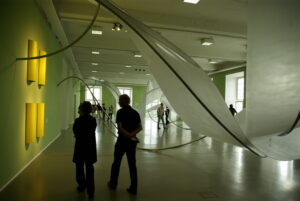
With their curatorial concept of the “migration of forms,” artistic directors Roger Buergel and Ruth Noack drew analogies that were often criticized as rather far-fetched formalism, but arguably did call attention to the complicated politics of visibility, power and re/presentation in exhibitions. Sometimes, moreover, these juxtapositions also very precisely documented how forms had migrated, fused and morphed historically. Yet, this focus on aesthetic experience, transcultural entanglements and the politics of form/lessness does not imply that documenta 12 stopped diversifying the scope of regions from which participating artists were selected. On the contrary: so far, d12 is the exhibition with the highest number of art from beyond North American and Western Europe. The ratio of exhibiting artists living in Europe or US dropped to “61 per cent in 2007,” which means that 40 % of the participants in documenta 12 lived outside of North-America and Europe and even more were born outside these centers.[50] Nevertheless, the curators refused to make this information of national affiliation and cultural identity a relevant factor in the promotion and reception of the exhibited art, for instance, omitting information on the artist’s nationalities from the labels. As they write in the catalogue intro:
[…] people are not really well equipped to deal with radical formlessness. They tend to feel the challenge deeply and they counter this challenge by seeking for identity. But how does one keep the balance between identification and fixation? Art can teach us this discipline. It was not our aim either to highlight artist’s names or to succumb to all-encompassing concept, nor did we want to favour geopolitical identity (a la ‘art from India’). […] It is equally true that art is not without context; each work is attached to a local history.[51]
So while their selection of artists bears witness to the curators’ hidden agenda of affirmative action, their insistence on countering tokenism with radical formlessness simultaneously deconstructed processes of identification. Their experimentation with a number of historical exhibition conventions and their effects on artworks and viewers alike, called attention to the ways in which curatorial choices beyond the mere selection of contents actively contribute to meaning-making in exhibitions. With their shift of attention from origins of artworks to context of their reception, they not only just changed the “content of the conversation,” but also the “terms of the conversation,” as Walter Mignolo demands.[52] While commentators have argued that d12 was a bourgeois depoliticization of art by decontextualization, I would say that it was political in the sense that its ostentative re-contextualization of artworks in a number of deliberately artificial environments challenged not only the essentializing idea that artworks should remain rooted in their contexts of production but also contributed to liberating artists from the burdens of cultural representation. Furthermore, attention to the governmental effects and the ways in which exhibitions position subjects and guide their attention, challenged the idea that exhibitions are democratic simply because they represent a diversity of participants from different cultural backgrounds or provide spaces of assembly for cultural publics to constitute themselves. Instead of claiming to provide a neutral podium for everyone to speak and become visible, documenta 12 called attention to the conditions, possibilities and effects of re/presentation and of constructing such a public, a public that is always constituted by hierarchies, power relations and incompleteness.
By thus taking into account the violent backside of exhibitions as necessarily exclusive apparatuses of identity and subject formation, d12 acknowledged the “impossibilities of representation” as the very condition not just of exhibition making but of politics in general. And it is this insight that is amongst the most valuable things I learned from documenta. Since 2007, when I was working at its twelfth edition as an educator/mediator/guide, the lesson of the impossibility of representation has stayed with me and informed my research on the socially reproductive functions of curating as an emancipatory practice and an instrument of power. Analyzing the gendering of exhibitions from a materialist feminist perspective, my research of the past years has looked at how discourses and practices of curating reflect biopolitical shifts from disciplinary societies to control societies or from hard power to soft power (as theorized, for example, by Michel Foucault in the History of Governmentality or by Gilles Deleuze “PS on Societies of Control.”)[53] Since such a praxeological perspective entails special attention to the often unavoidable (self-)contradictions and gaps that occur between theory and praxis or between the curators’ intentions and the effects of their practice, I would like to end this text with two snapshots from documenta 14 that illustrate this problematic and serve as a reminder that a declared ethics of representation always invites being measured by its own standards.
Spectacles of Diversity, or: the Exhibition as a Parliament of Bodies
Both, in Athens and in Kassel, documenta 14 (2017) drew heavily on visual and verbal metaphors from the political realm. With forums, columns, amphitheaters and other props of democracy appearing in many of the exhibition’s works, texts and display features, d14 clearly drew on the legacy of its first host city Athens in a way that almost fetishized the city as the birth place of modern democracy. Before the exhibition was opened in Athens, the so-called “Parliament of Bodies,” devised by co-curator Paul Preciado, started to operate in Parko Elefterias. This curated playground parliament eventually moved to the historical heart of the exhibition series in Kassel, where Andreas Angelidakis’ soft and reconfigurable building blocks of democracy, this time in military camouflage, were situated in the Museum Fridericianum’s Rotunda, inviting the exhibition’s public to take part in shaping this artistic “parliament” according to their needs and wishes. While the blocks in Athens were dressed in marble/cement optics referring to the birth of democracy in ancient Greece on the Pnyx and the Bauhaus inspired architectural modernism of Athenian polykatoikies,[54] here the camouflage textile and the original figuration of the blocks in the shape of a tank call attention to the fact that German democracy and documenta are children of war and destruction, also nodding to Kassel’s significant role in the arms production from the 19th century until today and thus inviting reflections on the site’s necro- and biopolitical implications. (Figs. 6a+b)
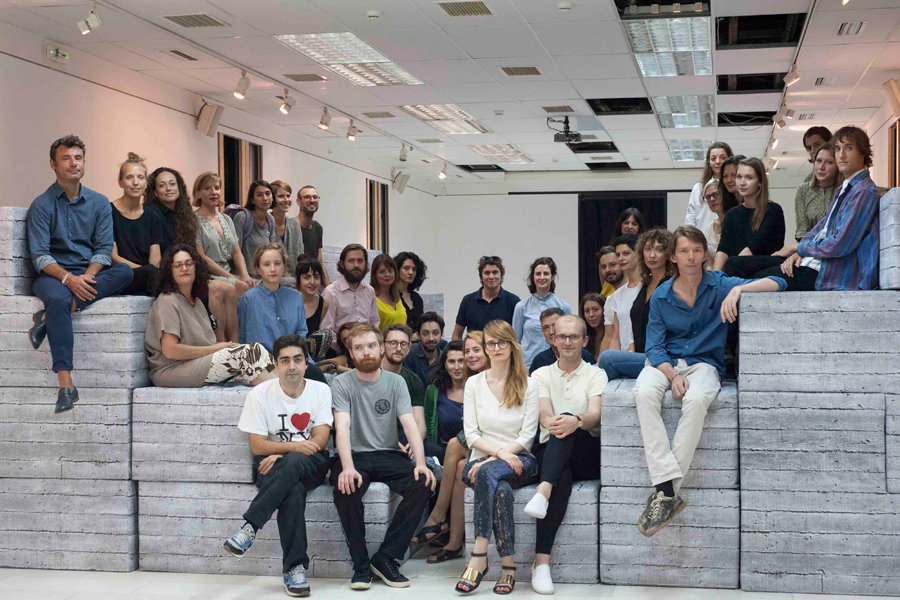
Installation by Andreas Angelidakis
The curatorial team of documenta 14, taken at Parko Eleftherias, Athens.
Photo Courtesy of Stathis Mamalakis
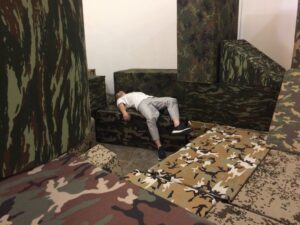
Besides the symbolic pathos of its artistic design, a lot more could be said about the specific ideas of democracy and body politics this curatorial gesture implied. While an analysis of the forum’s actual operation during, before, and even after d14 with regard to its micro-political potentials on the one hand, but also the unavoidable paternalisms of staged polyphony on the other, would fill an entire new paper, I will conclude by only very briefly pointing to yet another “Parliament of Bodies” that was performed during documenta 14’s opening press conference in Athens.
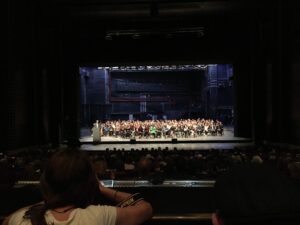
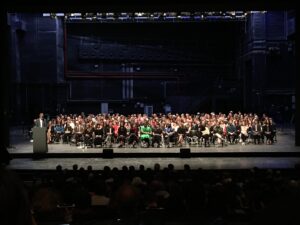
Sitting in the dark auditorium of the Megaron concert hall in curiosity, eventually a curtain was lifted to expose the image of a carefully curated group of people.[55] (Fig. 7a+b) Their positioning vis-à-vis the audiences below eye-level was certainly intended to not just mirror and elevate those representatives of the public, who had the exclusive privilege to attend to this event as members of the press and professional crowd, but also to suggest d14’s non-hierarchical and democratic form of organization. Instead of merely having the artistic director perform his representative function to officially open the exhibition, large parts of the team were present here and re/presented as equal members, all sitting on the same level, with the exception of those selected members of the core group who successively moved from their seats in the front row to a foregrounded lectern to give their speeches. This mise-en-scène was clearly devised to decenter the attention from the artistic director Adam Szymczyk and to portrait d14 as a collective endeavor of a multiplicity of diverse people from different cultural backgrounds. This ostentative showcasing of polyphony and plurality on all levels of the event, however, rendered the idea of democracy that this group of people was supposed to embody/represent dubious because their presence appeared as a carefully composed image/representation of diversity that said very little about power relations behind the scenes. Looking at this staging of diversity, it is important to keep in mind that the ethics of representation, which has become an imperative for curators working in the global field, and the promises of diversification, articulated by museum and exhibition policies of inclusion, sometimes despite best intentions risk playing into the invisible hands of capitalism’s domestication of radical alterity and potentially disjunctive difference. So let’s not forget that diversity is not democracy, and although exhibitions can be important sites in the struggle for (more) democracy and diversity, they are rarely democratic themselves.
Nanne Buurman is an author, editor, curator and educator working as an associate researcher and lecturer for documenta and exhibition studies at the Kunsthochschule Kassel, where she has been part of the team building the documenta Institut since 2018. In that capacity, she was involved in founding the Transdisciplinary Research Center for Exhibition Studies TRACES and is currently co-heading a research group on Nazi continuities at documenta. After graduating from Leipzig University, she was a member of the International Research Training Group InterArt at the Freie Universität Berlin and a visiting scholar at Goldsmiths College in London, supported by a DFG scholarship for her doctoral research on the gendered economies of curating. Buurman worked as an adjunct lecturer at the universities/art academies of Leipzig, Hildesheim, and Bremen, and has been involved in numerous art education, exhibition, and publication projects, such as the project Arbeitslose als Avantgarde (the unemployed as an avant-garde), which she organized in the framework of documenta 12, or the Networks of Care program, which she currently co-curates at nGbK in Berlin. Her research and publications focus on exhibition studies, the politics, economies and epistemologies of curating, the past and present of documenta, the shifting roles of race, class and gender in artistic and curatorial practice, as well as the transcultural conditions of cultural production in a global context. She co-edited documenta: Curating the History of the Present (with Dorothee Richter, 2017), Situating Global Art: Temporalities – Topologies – Trajectories (with Sarah Dornhof, Birgit Hopfener and Barbara Lutz, 2018) and serves as an editor of the research platform documenta studies, which she co-founded with Nora Sternfeld, Carina Herring, and Ina Wudtke in October 2018.
Endnotes:
[1] Donald Preziosi: Brain of the Earth’s Body. Art Museums and the Phantasms of Modernity, Minnesota UP 2003, p. 117.
[2] Ibid., p. 98/99.
[3] Ibid., p. 114.
[4] Ibid., p. 118.
[5] Ibid. p. 149.
[6] Tony Bennett: “Exhibition, Truth, Power. Reconsidering ‘The Exhibitionary Complex’”, in: documenta 14 catalogue, Prestel: Munich 2017, p. 346.
[7] Ibid.
[8] Cited ibid., p. 347.
[9] Peggy Phelan: Unmarked. The Politics of Performance, Routledge: New York/Abingdon 1993, p. 6.
[10] See http://www.documenta14.de/en/venues/21726/neue-galerie.
[11] Viktoria Schmidt-Linsenhoff: “Das koloniale Unbewusste in der Kunstgeschichte,“ in: Beatrice von Bismarck/Irene Below (eds.): Globalisierung / Hierarchisierung. Kulturelle Dominanzen in Kunst und Kunstgeschichte, Jonas: Marburg 2005.
[12] See Walter Grasskamp: Unbewältigte Moderne. Kunst und Öffentlichkeit, Suhrkamp: Frankfurt am Main 1989.
[13] For the ‘Germanic roots’ of Haftmann’s notions of abstraction and his post-war repurposing of nationalist and racist concepts in the context of documenta, see Nanne Buurman: “Northern Gothic. Werner Haftmann’s German Lessons, or A Ghost (Hi)Story of Abstraction,” in: documenta studies, No 11, December 2020. See also idem.: “d is for democracy? documenta and the Politics of Abstraction between Aryanization and Americanization,” in: A Recurring Occurrence: Biennials and Perennial Exhibitions of Contemporary Art, Special Issue of Modos. Revista de História da Arte, Campinas, Vol. 5, No. 2, June-August 2021, pp. 338–355.
[14] See Buurman: “The Exhibition as a Washing Machine,” in: Stasis: Taking a Stance, reader of the 7th Thessaloniki Biennale, ed. by Syrago Tsiara and Louisa Avgita for MOMus, Thessaloniki 2020. See also idem.:”
[15] See Grasskamp: “Becoming Global: From Eurocentricsm to North Atlantic Feedback – documenta as an ‘International Exhibition’ (1955-1972)“, in: Nanne Buurman/Dorothee Richter: documenta. Curating the History of the Present, OnCurating 33, June 2017.
[16] See Lotte Philipsen: Globalizing Contemporary Art, Aarhus UP 2010, p. 37.
[17] As Chin-Tao Wu puts it in her text “Biennials without Borders?,” New Left Review, 57, May/June 2009, p. 109, “[…] the actual numbers of artists, and the range of countries they come from, prove to be centrally embedded in the psychology of biennial organizers and feature prominently in their marketing strategies.”
[18] See Eva Cockcroft: “Abstract Expressionism as a Weapon of the Cold War,” in: Art Forum, Vol.12, No.10, June 1974.
[19] The past three sentence are only slightly rephrased versions of sentences I wrote in the editorial for documenta. Curating the History of the Present. See Buurman/Richter: “documenta. Curating the History of the Present”, in: OnCurating 33, June 2017, p. 2.
[20] See Harald Kimpel: documenta. Mythos und Wirklichkeit, DuMont: Colone 1997, p. 192-199.
[21] See ibid.
[22] See Daniel Buren: “Exposition d’une exposition/Ausstellung einer Ausstellung”, in: catalogue of documenta 5, Bertelsmann: Kassel 1972, 17.29.
[23] See Wu: “Biennials without Borders?” p. 110.
[24] Ibid., p. 112.
[25] Below/von Bismarck (eds.): Globalisierung / Hierarchisierung. Kulturelle Dominanzen in Kunst und Kunstgeschichte, p. 33.
[26] See Jan Hoet: “An Introduction,” catalogue of Documenta IX,” Vol. 1, Hatje Cantz: Ostfildern 1992, p. 18.
[27] See Kathryn Floyd: “George Adéagbo. Between Artwork and Exhibition”, in: Andrew Graciano (ed.): Exhibiting Outside the Academy, Salon, Biennial, 1775-1999: Alternative Venues for Display, Ashgate 2015.
[28] As paraphrased by Monica Juneja: “Global Art History and the ‘Burden of Representation’” in: Hans Belting et al. (eds.): Global Studies. Mapping Contemporary Art and Culture, Hatje Cantz: Ostfildern 2011, Cf. Kobena Mercer: “Black Art and the Burden of Representation,” in: Third Text, No. 10, 1990.
[29] Rasheed Araeen: “In the Heart of the Black Box,” in: Art Monthly, N° 259, 2002, p. 15.
[30] Catherine David: “Introduction”, in: documenta X Short Guide, Cantz Ostfildern 1997, p. 11/12.
[31] Araeen: “In the Heart of the Black Box,” p. 15.
[32] Wu: “Biennials without Borders?” p. 110.
[33] Ibid., p. 114.
[34] See Oliver Marchart: “Hegemonic Shifts,” in: Elena Filipovic, Marieke van Hal and Solveig Øvstebø (eds.): The Biennial Reader, Hatje Cantz: Ostfildern 2010, p. 474.
[35] The other discursive platforms of D11 dealt with issues of truth, justice, creolization, and African Megacities.
[36] See his contribution in Documenta11. Platform 1: Democracy Unrealized, ed by documenta GmbH, Hatje Cantz: Ostfildern 2002.
[37] Okwui Enwezor: “The Black Box,” in: catalogue of Documenta11, Platform 5, Hatje Cantz: Ostfildern, p. 44.
[38] A lot has been said and written about this elsewhere. See for instance Carolyn A. Jones: “Biennial-Culture: A Longer History,” in: Filipovic/van Hal/Øvstebø (eds.): The Biennial Reader.
[39] Filipovic/van Hal/Øvstebø (eds.): The Biennial Reader.
[40] Peter Weibel: “Jenseits des weißen Würfels. Kunst zwischen Kolonialismus und Kosmopolitismus,” in: idem. (ed.): Inklusion: Exklusion. Versuch einer neuen Kartografie der Kunst im Zeit- alter von Postkolonialismus und globaler Migration, DuMont: Colone 1997, p. 9, my translation.
[41] This relates to questions regarding the use of English as a colonial language in the context of Decolonization movements. See Dipesh Chakrabarty: “Legacies of Bandung: Decolonization and the Politics of Culture”, in: Postwar, exhibition catalogue, Munich 2016.
[42] Wilfried Kühn in conversation with Ute Meta Bauer: “Documenta 11”, in: Displayer, No. 1, April 2007, p. 101, my translation.
[43] Marchart: “Hegemonic Shifts”, p. 471, emphasis in original.
[44] Ibid. p. 463.
[45] Ibid. p. 486.
[46] Enwezor: “The Black Box,” p. 45.
[47] Ibid., p. 44.
[48] See Buurman: “Exhibiting Exhibiting. documenta 12 as a Meta-Exhibition”, in: Kunstexte 3, 2016.
[49] Mary Louise Pratt: Imperial Eyes. Travel Writing and Transculturation, Routledge: London / New York 2009.
[50] Wu: “Biennials without Borders?”, p. 110. See also Ring Petersen: “Migration into Art. Transcultural Identities and Art-Making in a Globalized World,” p. 68
[51] Roger M. Buergel/Ruth Noack: “Preface”, in: catalogue of documenta 12, Taschen: Colone 2007, p. 11.
[52] Walter D. Mignolo: “Epistemic Disobedience. Independent Thought and De-Colonial Freedom,” in: Theory, Culture & Society, Vol. 26 (7–8), 2009, p. 4.
[53] For my extensive research on this with regard to dOCUMENTA (13) see for instance Buurman: “CCB with… Displaying Curatorial Relationality in dOCUMENTA (13)s Logbook,” in: Journal of Curatorial Studies, 5.1, June 2016 and “Angels in the White Cube? Rhetorics of Curatorial Innocence at dOCUMENTA (13),” in: OnCurating, 29, Zürich, Mai 2016. With its post-humanist extension of attention to the agency of plants and animals as well as other organic and non-organic actants d(13) could be described as an attempt to realize a Latourian “parliament of things.” Parlament der Dinge (Parliament of Things) is the German title of Latour’s book Politics of Nature, published in English by Harvard UP, 2004.
[54] This style was realized in buildings like the d14 venue Athens Conservatoire (Odeion), whose basement amphitheater was open during d14 to host a piece by Emeka Ogboh.
[55] See also Nora Sternfeld: “Something didn’t feel right”, documenta studies #05, March 2019.

